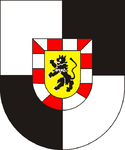Hohenzollern-Hechingen
|
||||||||||||||||||||||||||||||
Hohenzollern-Hechingen was first from 1576 a county and from 1623 to 1850 a principality with the residence town of Hechingen . Before the county of Hohenzollern-Hechingen existed the county of (Hohen-) Zollern . The area represents the ancestral lands of the Hohenzollern . Hohenzollern-Hechingen was territorially largely unchanged since 1576. As the last prince of Hohenzollern-Hechingen, Constantine resigned in 1849. The occupation by Prussia took place in 1850. The family branch went back to the original Hohenzollern, first mentioned in 1061. The principality of Hohenzollern-Sigmaringen existed at the same time .
history
The progenitor of the Hechingian line was Eitel Friedrich IV (* 1545, † 1605), a son of Count Karl I of Hohenzollern . Eitel Friedrich inherited the homeland of the Hohenzollern family and moved the seat of government to Hechingen . The count had a castle built where the New Castle in Hechingen was later built . The city of Hechingen was founded by the Hohenzollern in 1255.
Eitel Friedrich's son Johann Georg was raised to the rank of imperial prince by Emperor Ferdinand II in 1623 . In the very friendly formulated diploma it was determined that the following firstborns would also be princes. Now Hohenzollern-Hechingen was a ducal county, which meant that the family had almost all property rights and the emperor and the empire were not allowed to influence. A few manageable payments from old obligations still had to be made. After Johann Georg's death, the reign passed to his son Eitel Friedrich II . He died childless, so that his brother Philip became the new prince. Philip was initially earmarked for a spiritual career and became canons of Cologne and Strasbourg . He succeeded his brother as prince in 1661.
In the next generation with Friedrich Wilhelm , a greatly improved legal situation arose with the succession of younger sons and their descendants, brought about by Emperor Leopold I. Until now, the dignity of the imperial prince was associated with the primogeniture . Now the younger children and their descendants also had the option of inheritance. The next Prince Friedrich Ludwig died childless in 1750. Now the possibility has already been used that not only the firstborn and his descendants could become princes. Josef Friedrich Wilhelm , a cousin of the last regent, took over the management responsibility. The marriages of Prince Josef Friedrich Wilhelm also remained without male heirs, and his nephew Hermann came to power in 1798. In the same year serfdom was abolished in the principality. Through the secularization of 1803, Hermann received, among other things, the Stetten monastery . Hohenzollern-Hechingen became a member of the Rhine Confederation in 1806 and was no longer part of the Holy Roman Empire of the German Nation . Hermann's son Friedrich then became the new prince in 1810. During his reign, Hohenzollern-Hechingen joined the German Confederation created at the Congress of Vienna in 1815 .
The principality had not been mediatized in 1806 , which was by no means a matter of course with 14,000 inhabitants. Territorial gains through the Reichsdeputationshauptschluss were small at Hohenzollern-Hechingen. In the Principality of Hohenzollern-Sigmaringen , which was ruled by a different part of the family, it was different. The administration in Hohenzollern-Hechingen was gradually redesigned, and in 1848 the administration of justice and administration were organized separately. In the period before the reform, the offices subordinate to the princely authorities performed both tasks together. The principality was the territory of the Swabian Empire until 1808 .
As the last prince, Constantine ruled until December 7, 1849. After that, Hohenzollern-Hechingen became part of Prussia , which took over the principality on April 8, 1850. It then belonged to the Sigmaringen administrative district , the Hohenzollern Lands . Prince Konstantin was buried in the collegiate church Sankt Jakob in Hechingen, the burial place of the Hohenzollern. During the French occupation after the Second World War , the state of Württemberg-Hohenzollern with the capital Tübingen was established , to which the former principality then belonged. In 1952 the state of Baden-Württemberg was created.
Old Hechingen Castle, today the Hohenzollerisches Landesmuseum
Villa Eugenia in Hechingen
Location and administration
Hohenzollern-Hechingen bordered the Principality of Hohenzollern-Sigmaringen in the west and east and the Kingdom of Württemberg in the north and south . In addition, the Wilflingen exclave was part of the national territory. The principality had around 20,000 inhabitants in 1849, the main town Hechingen around 3,000 inhabitants. The Hohenzollern higher offices were used to administer Hohenzollern-Hechingen and Hohenzollern-Sigmaringen. In Hohenzollern-Hechingen there was only the Hechingen Oberamt for the administration of the entire country. From 1825 the highest court was the upper tribunal in Stuttgart . Before that, the higher appellate court in Darmstadt had the same position. The population was mostly Catholic. There was a Jewish community in Hechingen.
For the judiciary, see the list of courts in the Principality of Hohenzollern-Hechingen .
Regents

The rulers of Hohenzollern-Hechingen were:
- Vain Friedrich I. (IV.) (1545–1605)
- Johann Georg (1577–1623)
- Eitel Friedrich II. (1601–1661)
- Philip (1616–1671)
- Friedrich Wilhelm (1663–1735)
- Friedrich Ludwig (1688–1750)
- Josef Friedrich Wilhelm (1717–1798)
- Hermann (1751-1810)
- Friedrich (1776-1838)
- Constantine (1801-1869)
See also
- Tribe list of the Hohenzollern , there the line Hohenzollern-Hechingen
Web links
- Statistical and historical information on the Principality of Hohenzollern-Hechingen at HGIS
- Constitutional Charter of May 16, 1848
- Contract for cession of the Principality of Hechingen dated December 7, 1849
- Family tree and life data of the Hohenzollern
- Hohenzollern-Hechingen at flaggenlexikon.de
Individual evidence
- ^ History of the Stetten Monastery
- ↑ Stiftskirche Sankt Jakob in Hechingen ( page no longer available , search in web archives )
- ^ Jewish community in Hechingen








